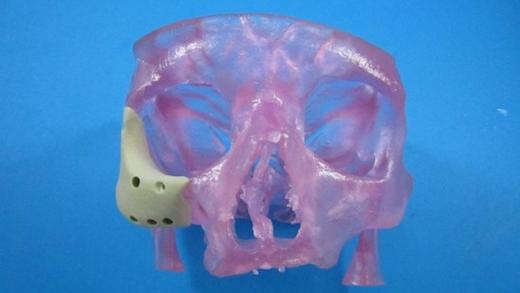
Hospitals might soon end up with 3D printers next to their X-ray machines now that the FDA has approved a 3D-printed skull bone replacement implant. The implant, technically called the OsteoFab Patient-Specific Facial Device (OPSFD), is basically a specialized hard plastic that is similar to bone, and printed in to finely mimic the facial bone that is missing in shape and function. If your cheek bone were to be shattered beyond normal repair, this implant could help ensure you could soon look and function about as well as you did before. Oxford Performance Materials, which created the implant, was also the first to get FDA approval a similar implant for the cranium, the part of the skull that is not the face.
"There has been a substantial unmet need in personalized medicine for truly individualized - yet economical - solutions for facial reconstruction, and the FDA's clearance of OPM's latest orthopedic implant marks a new era in the standard of care for facial reconstruction," said Scott DeFelice, OPM's CEO in a statement. "Until now, a technology did not exist that could treat the highly complex anatomy of these demanding cases. With the clearance of our 3D printed facial device, we now have the ability to treat these extremely complex cases in a highly effective and economical way, printing patient-specific maxillofacial implants from individualized MRI or CT digital image files from the surgeon."
It's an amazing reminder that 3D printing for manufacturing and industry is taking off in all sorts of ways. It's gone rapidly from a fun way to make personalized jewelry, to a source for rocket engine parts and more. The materials and process for making the facial implants are an extraordinary level above the simple laying-down of plastic that 3D-printing started with. And as the ability to digitally model objects, including bones, improves, there's no telling how much 3D printing could do to help people, and for a surprisingly low-cost for what sounds like a very science fiction kind of procedure.
"An exciting aspect of our technology is that additional complexity does not increase manufacturing cost, and having both cranial and facial devices cleared now enables us to answer ever more complex cases where upper facial structures can be incorporated with cranial implants as a single device," said Severine Zygmont, president of OPM Biomedical. "As a result, additive manufacturing has the potential to not only improve patient outcomes, but fundamentally improve the economics of orthopedics on a global scale – for developed and developing countries. These are disruptive changes that will allow the industry to provide the finest levels of healthcare to more people at a lower cost."
Don't expect the bone replacements to be available right away at your nearest hospital, OPM's distributor Biomet is still working up the process by which the requests for implants will get processed. Still, it's hard not be excited about a way to cheaply help people who need facial bone replacements for whatever reason.
"This is a classic example of a paradigm shift in which technology advances to meet both the patient's needs and the cost realities of the overall healthcare system," DeFelice said.




